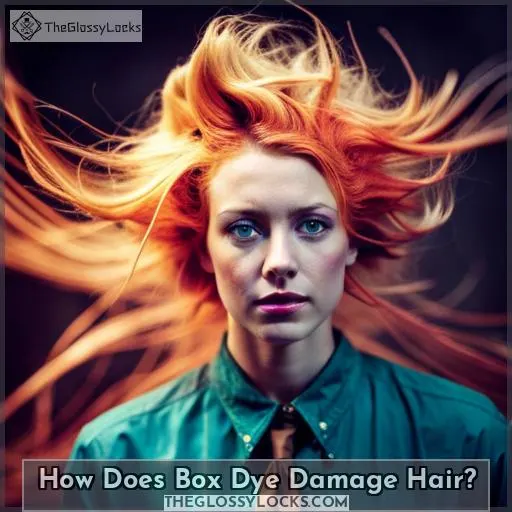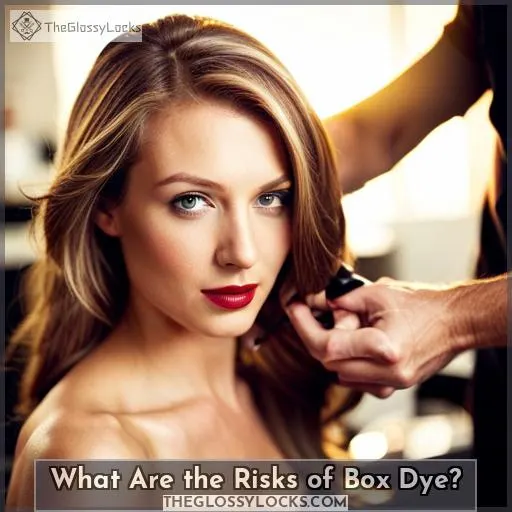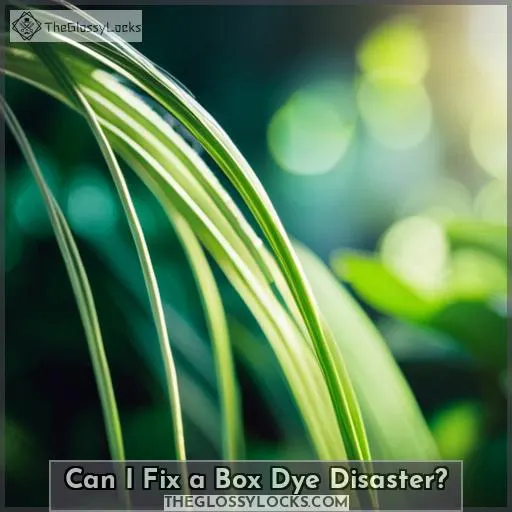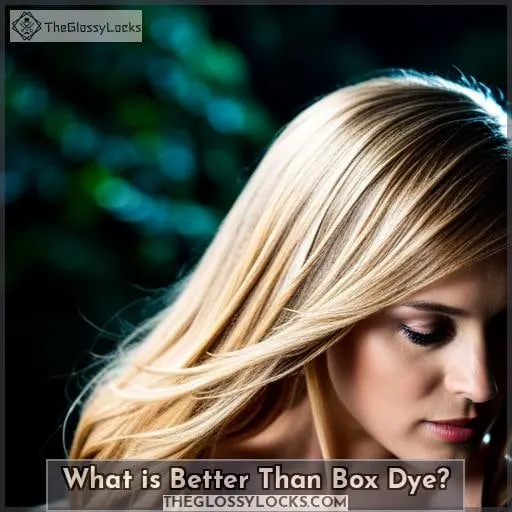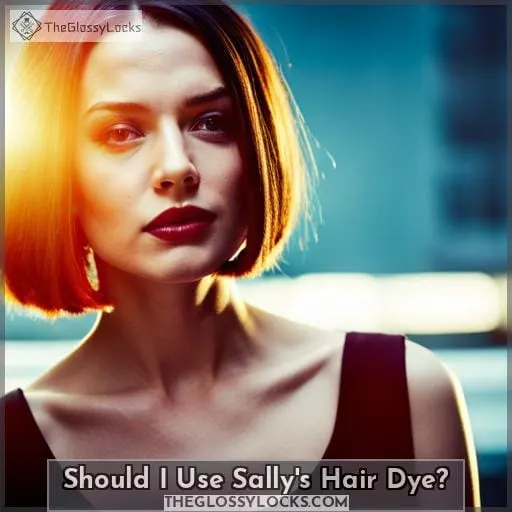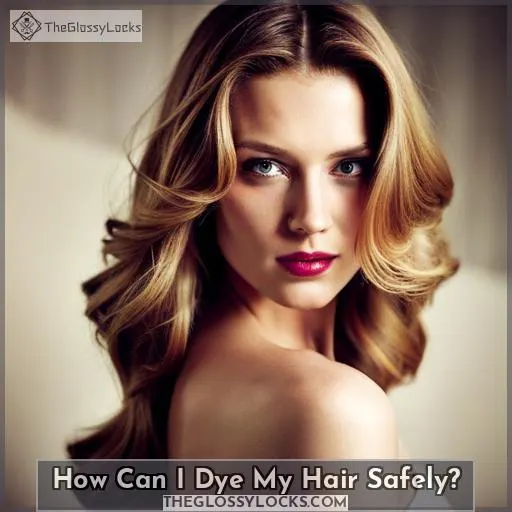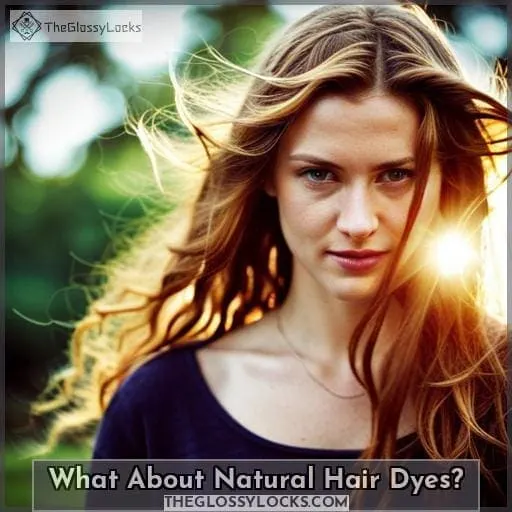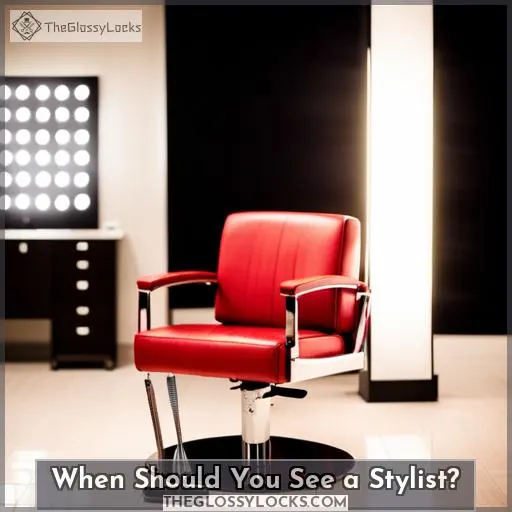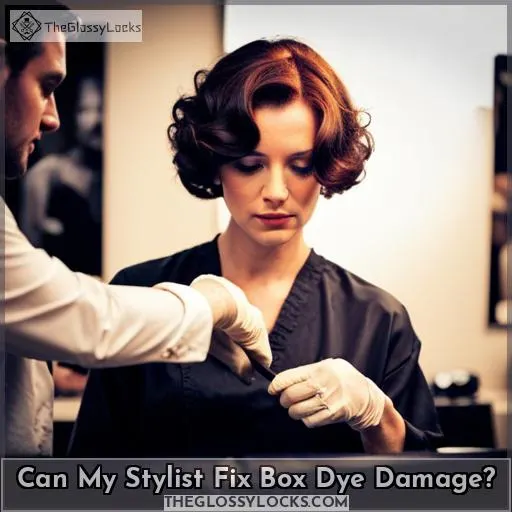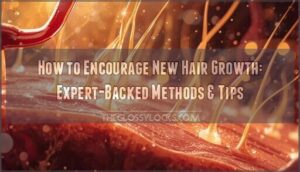This site is supported by our readers. We may earn a commission, at no cost to you, if you purchase through links.
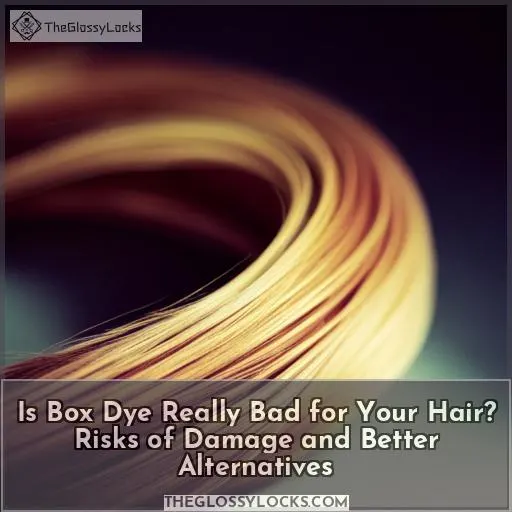
Box dye is notorious for damaging hair, and it can often lead to disastrous results.
In this article, we’ll explore the risks of using box dye and provide you with better alternatives that won’t harm your hair.
We’ll also discuss when you should see a stylist and how they can help you fix any box dye damage.
So, before you reach for that box of dye, read this article and learn why box dye is really bad for your hair.
Table Of Contents
- Key Takeaways
- How Does Box Dye Damage Hair?
- Why Doesn’t Box Dye Work?
- What Are the Risks of Box Dye?
- Can I Fix a Box Dye Disaster?
- What is Better Than Box Dye?
- Should I Use Sally’s Hair Dye?
- How Can I Dye My Hair Safely?
- What About Natural Hair Dyes?
- When Should You See a Stylist?
- Can My Stylist Fix Box Dye Damage?
- Frequently Asked Questions (FAQs)
- How can I prevent further damage to my hair after using box dye?
- What are some temporary hair color options that are less damaging than box dye?
- Are there any natural or DIY alternatives to box dye that are less harmful to hair?
- How often should I get my hair professionally colored to maintain healthy hair?
- What are the signs that my box dye damage is too severe for home remedies and requires professional intervention?
- Conclusion
Key Takeaways
- Box dyes contain harsh chemicals that can damage hair, leading to increased porosity, breakage, and uneven color.
- Alternatives to box dyes include professional color, semi-permanent dyes, natural hair dyes, protective treatments, and strand tests.
- Professional help is necessary for bleaching hair, color correction, and addressing severe box dye damage.
- Preventing further damage involves deep conditioning, protein treatments, avoiding heat styling and chemical processes, and using temporary hair color options.
How Does Box Dye Damage Hair?
Box dye can damage your hair due to its harsh chemicals and incorrect application.
The chemicals in box dyes, like ammonia and peroxide, can strip your hair of its natural oils, making it dry, brittle, and prone to breakage.
Additionally, if you don’t apply box dye correctly, you can end up with uneven color, splotches, or even hair loss.
Harsh Chemicals
- Box dyes can damage your hair due to their harsh chemical composition. These chemicals strip your hair of its natural oils, leaving it dry, brittle, and prone to breakage.
Ammonia: This harsh chemical opens up the hair cuticle, allowing the dye to penetrate.
Peroxide: This bleaching agent lightens your hair by removing its pigment. However, it can also damage the hair’s protein structure, leading to breakage.
PPD (p-phenylenediamine): This common dye ingredient can cause allergic reactions, including itching, swelling, and blisters.
Protect your hair’s health by opting for gentler, chemical-free alternatives or seeking professional expertise for color treatments.
Incorrect Application
Incorrect application of box dye, a common pitfall for DIY hair colorists, can exacerbate the damage caused by harsh chemicals.
Uneven application leads to uneven processing, resulting in patchy results and color blending mishaps.
DIY challenges like improper sectioning and imprecise application contribute to uneven color distribution, leaving you with an unflattering outcome.
The harsh chemicals in box dyes can damage your hair structure, making it more susceptible to breakage and split ends.
Incorrect application exacerbates this damage, leading to further deterioration of your hair’s health.
If you’re considering box dyeing your hair, it’s crucial to understand the risks and take steps to minimize damage.
Why Doesn’t Box Dye Work?
Box dye’s one-size-fits-all approach ignores individual hair characteristics, leading to unpredictable results.
The lack of customization can result in:
- Uneven color
- Brassiness
- A shade that doesn’t match your expectations
This can be especially problematic if you have color-treated hair, as the box dye may not interact well with the existing color.
One Size Doesn’t Fit All
Box dye fails you because it can’t adapt to your hair’s unique needs and history. It’s a one-size-fits-all approach that disregards individual considerations like hair type, porosity, previous treatments, and color history.
Oversimplified Options:
Box dyes offer limited shade selections, forcing you to choose from a narrow range that may not complement your skin tone or hair color.
Lack of Customization:
Unlike professional hair color, box dyes don’t allow for custom blending or adjustments to accommodate your specific hair needs.
DIY Dangers:
Home coloring involves risks like uneven application, incorrect processing times, and potential damage from harsh chemicals.
Professional Expertise Lost:
You miss out on the knowledge and skill of a professional colorist who can assess your hair’s condition and create a tailored color solution.
Lack of Customization
Lacking specialized knowledge, you risk choosing a box dye that clashes with your unique hair characteristics and desired outcome.
Customization limitations and DIY drawbacks make it difficult to achieve salon-quality results.
Box dyes often fail to consider your hair’s porosity, texture, and underlying pigments, leading to color inaccuracies and application challenges. The ‘one-size-fits-all’ approach disregards individual hair compatibility, increasing the likelihood of unevenness, splotchiness, and brassiness.
Professional hair dyes offer a wider selection of shades and formulations, allowing stylists to tailor the color to your specific needs. Their expertise ensures precise application and adherence to proper techniques, minimizing the risk of damage and ensuring color accuracy.
What Are the Risks of Box Dye?
Box dye’s harsh chemicals can damage your hair, leading to increased porosity and potential breakage.
The one-size-fits-all approach of box dyes often results in uneven color, as they lack the customization and expertise of professional colorists.
Additionally, box dyes can leave behind unwanted color buildup, compromising the integrity of your hair over time.
Damage From Chemicals
You’ll risk damaging your hair with harsh chemicals found in many box dyes.
These chemicals can have a significant impact on the health of your hair, leading to issues such as increased porosity and potential damage.
DIY application also poses risks, as improper color selection or application can result in unpredictable and uneven results.
It’s important to consider the longevity of color and take steps to prevent damage by using bond builders and appropriate hair care products.
Consulting with professional hair colorists is advised for a safer alternative that prioritizes both liberation from potential damage and understanding proper techniques for beautiful results.
Uneven Color
Uneven application, a common box dye pitfall, can lead to splotchy, unattractive results.
- Inconsistent application techniques, such as uneven spreading or neglecting hard-to-reach areas, can cause color variations.
- Failure to blend colors properly, especially when transitioning between shades, can result in noticeable lines or streaks.
- Ignoring patch testing can lead to allergic reactions or unexpected color outcomes, contributing to unevenness.
- Not adhering to recommended processing times can result in insufficient or excessive color development, leading to splotchy results.
Can I Fix a Box Dye Disaster?
If you’ve experienced a box dye disaster, don’t panic.
You can take steps to correct the color and restore your hair’s health.
Start by consulting a professional colorist who can assess the damage and recommend the best course of treatment.
Color Correction
When faced with a box dye disaster, color correction can be your savior, restoring your hair’s intended beauty.
Expert colorists wield their knowledge of color balancing, tonal harmony, and pigment blending to rectify the damage. They assess hair integrity, determining the best course of action to restore vibrancy and health.
Color correction involves the skillful application of corrective dyes to neutralize unwanted tones and achieve a cohesive, natural-looking result. This delicate process demands precision and expertise to avoid further hair damage.
While at-home coloring might seem like a quick fix, entrusting a professional with your hair’s health ensures a successful color correction, restoring your tresses to their former glory.
Treatments
To counteract the damaging effects of box dye, you can revitalize your hair with nourishing treatments that restore its strength and vibrancy.
- Deep conditioning masks, rich in natural oils and proteins, replenish lost moisture and nutrients, restoring hair’s elasticity and shine.
- Strengthening treatments, formulated with amino acids and ceramides, reinforce hair structure, reducing breakage and split ends.
- Professional color correction treatments, offered at salons, utilize specialized techniques and products to neutralize unwanted tones and restore hair’s natural color balance.
By investing in post-dye conditioning and strengthening treatments, you can mitigate the risks associated with box dye and maintain healthy, radiant hair.
What is Better Than Box Dye?
When it comes to alternatives that are better than box dye, there are two options worth considering:
Professional color offers superior quality and customized formulations compared to box dye kits.
Salons provide flexibility in mixing colors and developers, ensuring tailored and conditioned results.
Semi-permanent dyes offer a temporary solution for quick color changes without the long-term commitment or potential damage associated with box dyes.
Professional Color
Professional color offers superior coverage and customized results, giving you a salon-quality transformation.
Expert colorists possess the knowledge and experience to assess your hair’s unique characteristics and create a personalized color plan.
They wield a palette of high-quality dyes and developers, expertly mixed to achieve your desired shade while preserving hair health.
Embrace professional color for a radiant, long-lasting transformation that respects your hair’s integrity.
Compared to box dye’s limitations, professional color grants you access to a wider spectrum of shades, tailored to your skin tone and eye color.
Embrace the expertise of a colorist to guide you through the coloring process, minimizing risks and ensuring a satisfying outcome.
Let go of the constraints of box dye and unlock the gateway to a vibrant, healthy hair transformation.
Semi-Permanent Dye
Let’s explore semi-permanent dye, a gentler alternative to box dye, offering temporary color without the harsh chemicals.
Its user-friendly application makes it a DIY-friendly option, allowing you to experiment with various shades without long-term commitment.
However, remember that even semi-permanent dyes require careful application. Strand tests and following instructions are crucial to avoid uneven results.
If you encounter any mishaps, consult a stylist for professional color correction rather than attempting DIY fixes that may exacerbate the problem.
Regular touch-ups may be necessary to maintain your desired color, but semi-permanent dyes offer a less damaging way to keep your look fresh.
Should I Use Sally’s Hair Dye?
Considering Sally’s hair dye?
Understand the potential risks of damage from harsh chemicals and uneven application.
Explore alternative options like professional salon services or temporary color solutions
For a safer and more controlled hair coloring experience.
Risks
You’ll often hear warnings about using Sally’s hair dye, so let’s explore the risks and consider some alternatives.
Sally’s hair dye, like other box dyes, carries the risk of color misconceptions.
The DIY nature of at-home hair coloring can lead to uneven application and unexpected results.
Moreover, the harsh chemicals in box dyes can cause significant damage to your hair, increasing porosity and making it more susceptible to breakage.
Professional colorists often caution against using box dyes due to the lack of customization and potential for DIY challenges.
Instead, they recommend temporary solutions like hair wax or semi-permanent dyes that allow you to experiment with color without the commitment or damage of permanent dyes.
Alternatives
Now that you know the risks, let’s explore whether Sally’s hair dye is a better choice.
While it’s a popular DIY alternative, there are still risks associated with its use:
- The harsh chemicals in Sally’s hair dye can still damage your hair, especially with repeated use.
- The one-size-fits-all approach of box dyes may not suit your unique hair needs, leading to unsatisfactory results.
- Unlike professional colorists, you won’t have access to customized color formulations or the expertise to correct any mishaps.
If you’re serious about achieving your desired hair color without compromising its health, consider consulting a professional stylist.
Their expertise and access to higher-quality products can make all the difference.
How Can I Dye My Hair Safely?
To dye your hair safely:
- Start with a strand test to assess how your hair reacts to the dye.
- Use protective treatments, like Olaplex, before and after dyeing to minimize damage.
- Avoid leaving the dye on for longer than the recommended time.
Strand Test
Before committing to a full head of color, conduct a strand test with the dye on an inconspicuous section of your hair to check for any adverse reactions or unexpected results.
The benefits of performing this test are numerous.
First, it allows you to predict how the color will turn out on your hair before applying it all over.
Additionally, it serves as a sensitivity check to ensure that you don’t have any allergic reactions or irritations from the dye.
By assessing the reaction and observing gradual color change during this test, you can make informed decisions about using box dye and minimize potential damage risks associated with at-home hair coloring.
Protective Treatments
To dye your hair safely, consider the following:
- Use a pre-dye bonding treatment to strengthen your hair and minimize damage. This protective layer helps shield your hair from the harsh chemicals in box dye.
- DIY hair masks made with natural ingredients like coconut oil, avocado, or honey can also help nourish and protect your hair before and after coloring.
- Use a heat shield spray before blow-drying or styling your hair to further protect it from heat damage.
What About Natural Hair Dyes?
Natural hair dyes, such as henna and vegetable-based dyes, offer a gentler alternative to box dyes.
They’re typically free of harsh chemicals and less damaging to your hair’s structure.
These natural dyes can provide vibrant color while also nourishing and conditioning your hair.
Henna
Applying henna, a plant-based natural dye, can give your hair color and shine while potentially conditioning it.
Henna’s benefits stem from its ability to coat the hair shaft, resulting in fuller, thicker-looking strands. Unlike box dyes, henna doesn’t penetrate the hair shaft, minimizing damage and preserving hair health.
Henna application is relatively simple, involving mixing the henna powder with water or another liquid to form a paste, then applying it to the hair. The paste is left on for several hours, allowing the henna to release its color and bond with the hair.
Henna offers a wide range of color variations, from vibrant reds to deep blacks, depending on the type of henna and the addition of other natural ingredients.
When compared to box dyes, henna is generally considered safer and gentler on the hair. However, it’s important to note that henna is a permanent dye, meaning it doesn’t wash out and can be challenging to remove or alter.
Additionally, henna may not be suitable for all hair types or conditions, so it’s always best to consult a professional before using henna.
Vegetable-Based
- Now let’s explore the option of vegetable-based hair dyes as a natural alternative to box dye.
- Derived from plants, they’re gentler on your hair and scalp, minimizing the risk of damage.
- Henna, chamomile, and beetroot are popular choices, offering a range of natural shades.
- DIY vegetable-based dyes allow you to control the color intensity and avoid harsh chemicals.
- The results are often more subtle and natural-looking, preserving the health of your hair.
However, achieving specific shades or covering gray hair may be challenging, and professional intervention might be necessary for complex color transformations.
When Should You See a Stylist?
If you’re considering bleaching your hair or need color correction, it’s advisable to seek the expertise of a stylist.
Bleaching can be a complex process that requires skill and knowledge to avoid damaging your hair.
Similarly, if you have experienced box dye mishaps or want professional advice on achieving desired results, consulting with a stylist will ensure personalized guidance and minimize the risk of further complications.
If Considering Bleaching
If you’re considering bleaching your hair, don’t go it alone—see a stylist for expert guidance. DIY bleaching is a recipe for disaster, leading to uneven color, brassiness, and severe damage.
DIY Bleaching Pitfalls:
- Uneven Color
- Brassy Tones
- Severe Damage
Professional Intervention:
- Color Correction Expertise
- Stylist’s Knowledge of Toners
- Professional-Grade Products
- Colorist’s Skillful Application
A stylist will assess your hair’s condition, select the right bleach strength, and apply it expertly to achieve your desired look while preserving hair health.
For Color Correction
When should you seek a stylist for color correction after using box dye?
- DIY Fixes Won’t Cut It:
Don’t attempt DIY fixes like Color Oops or home remedies. These can worsen the problem, leading to further damage and uneven color.
- Professional Help Is Key:
Seek professional assistance for color correction. A stylist can assess the damage, determine the best course of action, and apply corrective color to restore your hair’s health and desired shade.
- Temporary Options Are Fleeting:
While temporary color solutions may offer a quick fix, they won’t address the underlying damage caused by box dye. Invest in professional color correction for long-lasting results.
- Prevention Is Better Than Cure:
To avoid the need for color correction, consider professional hair coloring from the start. A stylist can expertly select and apply color that suits your hair type and desired look, minimizing the risk of damage.
Can My Stylist Fix Box Dye Damage?
Since box dye damage can be significant, you should schedule an appointment with your stylist.
They will assess the extent of the damage and discuss potential corrective treatments.
Your stylist’s expertise is crucial in addressing box dye challenges and finding professional solutions for your hair.
They are trained in color correction techniques that can help restore your hair’s health and appearance.
During your salon intervention, your stylist will carefully evaluate the condition of your hair affected by box dye.
They will consider factors such as color intensity, unevenness, or unwanted tones.
Based on their assessment, they will recommend appropriate treatments to address these issues.
Color correction may involve processes like stripping away excess pigment or using specialized toners to neutralize undesired colors.
Your stylist may also suggest deep conditioning treatments or bonding therapies to repair any damage caused by harsh chemicals present in box dyes.
By seeking out a professional hairstylist who specializes in fixing box dye disasters through color correction methods and tailored treatments, you give yourself the best chance at achieving desired results while minimizing risks associated with DIY attempts at home.
Frequently Asked Questions (FAQs)
How can I prevent further damage to my hair after using box dye?
To minimize further hair damage after box dyeing, take immediate action:
- Use a deep conditioner to replenish moisture and strength.
- Consider a protein treatment to reinforce hair structure.
- Avoid heat styling and chemical processes until hair regains health.
What are some temporary hair color options that are less damaging than box dye?
Unleash your hair’s potential with temporary color options that dance on your strands without the harsh touch of box dyes.
Explore gentle alternatives that let your hair breathe and shine, all while expressing your vibrant spirit.
Are there any natural or DIY alternatives to box dye that are less harmful to hair?
Embrace your natural beauty with gentle alternatives.
DIY masks using coffee, henna, or beet juice offer vibrant, temporary hues.
Explore plant-based products for subtle shifts in tone.
How often should I get my hair professionally colored to maintain healthy hair?
Seeking professional hair coloring can transform your locks while preserving their health.
Regular touch-ups ensure vibrant, lasting color without compromising hair integrity.
Embrace expert guidance for a radiant, healthy mane.
What are the signs that my box dye damage is too severe for home remedies and requires professional intervention?
Brittle strands,
incessant breakage,
scalp irritation—
Signs your hair’s integrity is compromised.
Seek professional help
to restore its health
and vitality.
Conclusion
Of course, you might argue that you’ve used box dye before without any problems.
But remember, every head of hair is different, and what works for one person may not work for another.
Plus, the long-term effects of box dye can be devastating.
So why take the risk?
If you’re serious about coloring your hair, it’s best to leave it to the professionals.

